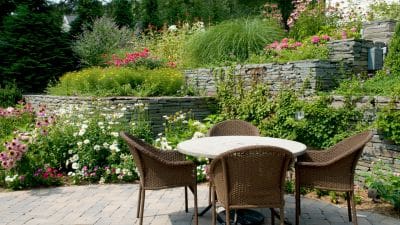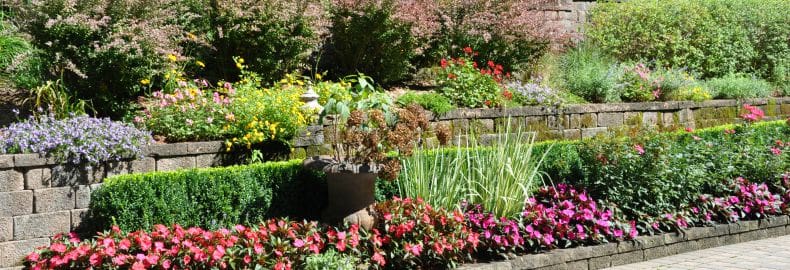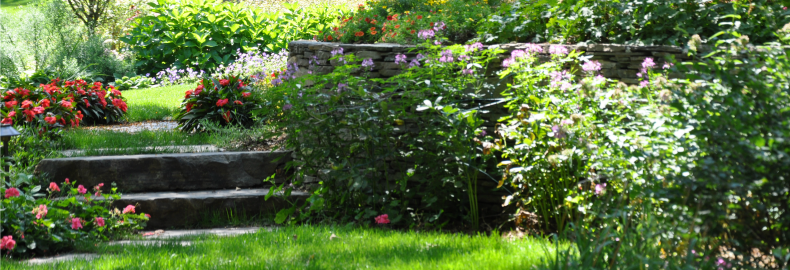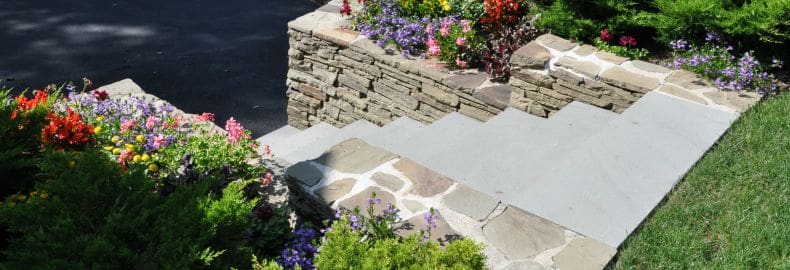 If your home is built on a steep slope or hillside, landscaping solutions can be quite challenging. A variety of landscape problems such as soil erosion, standing water, adequate irrigation, weed control, pest control and maintenance are common in these types of landscapes. If you have a family, steep slopes and hillsides also prevent a safe play for children and pets and leave little opportunity for outdoor activities and entertaining. Take a look at five great landscaping solutions that can quickly turn your neglected slopes and hillsides into beautiful, usable areas for your home.
If your home is built on a steep slope or hillside, landscaping solutions can be quite challenging. A variety of landscape problems such as soil erosion, standing water, adequate irrigation, weed control, pest control and maintenance are common in these types of landscapes. If you have a family, steep slopes and hillsides also prevent a safe play for children and pets and leave little opportunity for outdoor activities and entertaining. Take a look at five great landscaping solutions that can quickly turn your neglected slopes and hillsides into beautiful, usable areas for your home.
Create A Downhill Garden
By creating a wonderful downhill garden, you can prevent many problems that often occur from improper irrigation and soil erosion on sloped landscapes. With the right plants, you can create an easy-to-maintain, problem-free area that adds lush greenery, texture and color to your Bergen County home. When you landscape with plants, their root systems provide added protection against soil erosion by anchoring and spreading out into the ground. Plant roots help to stabilize and bind loose soil and absorb water as it comes down the hillside. A sloping landscape without plants is certain to suffer major erosion problems from water and wind due to loose soil that will wash down the hillside every time it rains.
Soil erosion can cause numerous problems that will require immediate landscaping solutions by a professional landscape contractor. When rainfall hits soil that is not protected by plants or some type of vegetation, there are no plant roots to stabilize the soil. Soil particles are immediately loosened and washed down the sloping landscape. Since the soil has to go somewhere, it will start to pile up when it reaches a level surface or wash into available drains on your property. You either end up with unwanted mud and dirt that you have to clear away or clogged drains from excessive dirt and rocks. If your landscape slopes downward towards your home, you can end up with mud and debris in your basement or home, as well as cracks in your foundation. If you live in an area that gets a lot of rainfall, erosion problems can cause constant problems that cost you thousands of dollars each year. When you have a sloped or hilly landscape, the steeper the slope, the greater the erosion due to the swiftness of water flow. The length of the slope is also important, because the longer the slope, the greater the concentration of the flooding water.
By planting proper plants for your sloping yard or hillside, you can create a stable, beautiful landscape for your home:
Groundcovers
Groundcovers provide cost-effective landscaping solutions that stabilize the soil. Certain types of groundcovers will quickly form a solid, soil-holding mass to bind the soil. When planting, you need to space plants rather close together and make sure you provide adequate water until roots become established. Placing large rocks or boulders within your planting area will also help prevent erosion problems and add visual interest to your landscape. Here are a few groundcover suggestions:
- Creeping Sedum – As one of the most versatile groundcovers, creeping sedum takes hold quickly in dry soil and sunny slopes without much need for irrigation, but it does need good drainage. Plants come in an array of beautiful colors that will enhance your landscape with vibrant color from winter through spring.
- Creeping Phlox – With shallow roots and horizontal stems, creeping phlox roots grow easily in most soil conditions. The hardy foliage remains lush year-round, and colorful spring blooms provide a thick bed of spectacular color.
- Ajuga Chocolate Chip – With persistent, fast spreading roots, this groundcover grows quickly and chokes out weeds with its thick growth. It provides beautiful lavender blooms and grows well on shady or sunny slopes.
- Daylillies – Daylilies form a thick carpet of soft white and yellow color. They are ideal for erosion control because their strong roots soak up water, then hold it for later use in dry, sunny weather. Daylillies have shorter growing seasons, but bloom every year.

Ornamental Grasses
Graceful ornamental grasses create beautiful landscaping solutions for steep slopes and hillsides. They grow well in sunny and shady conditions and provide additional height, texture and color to groundcovers and other hedge plants.
- Blue Festuca – Boulder blue festuca thrives in most any landscape condition. It’s a hardy perennial grass that has metallic blue tufts of semi-evergreen foliage from early spring through late fall. It grows well in high heat, humidity and drought without losing its beautiful blue color.
- Pennisetum – Pennisetum Karley Rose is a great ornamental grass for sunny slopes. It’s a heavy bloomer that produces rose-purple plumes from summer to late fall. It grows well in high heat and drought conditions without too much water.
- Hakone Grass – Gold hakone grass has slender arching stems with bright yellow-gold leaves from spring through late fall. Its bamboo-like texture will give visual interest to any hillside landscape, and it offers deer-proof landscaping solutions.
- Dwarf Pampas Grass – If you want a plant that’s showy and extra hardy, dwarf pampas grass is a great choice. In mid summer, 5 foot tall clumps topped with fluffy white plumes will flower for 10 to 12 weeks and provide great texture to your landscape.
Terrace The Slope
When you have a steep slope or hillside for a back yard, creating terraced levels will give you areas that are usable for seating and entertaining. Building several low walls with a level terrace between each wall will make the slope feel less steep than building one big wall at the bottom of the slope. A lower level patio near the house will create a perfect setting for outdoor dining and entertaining. A cozy, inviting mid-slope patio will create a comfortable place to relax with your morning coffee or your favorite novel as you look out over your garden.
Depending on your existing landscape conditions and the length and slant of your slope, you can create various terraced levels that gradually progress downward with steps or connect by winding pathways. Either way, you can create beautiful terraced levels that provide functional landscaping solutions and features that enhance your home.
- Backyard Garden – If you love gardens, consider terraced levels surrounded by perennial cutting gardens, specialty gardens and herb gardens. You can create a different type of garden on each level.
- Pool and Spa – With a steep slope, building a pool and spa may be difficult, but not impossible. By terracing the spa high up in the yard, you can take advantage of the view. Build the pool where the slope starts to level out, then connect the levels with steps or pathways.
- Outdoor Spaces – Consider terraced levels that create tiered outdoor spaces. If your backyard slopes away from your house, step out of your house onto a terrace for dining and entertaining. Head down to the next level for cozy seating, then down again to a lovely rose garden.
- Double-Duty Walls – If you don’t have enough space for patio areas, terraced walls can be built to incorporate seating. Create beautiful stone walls with built-in benches that provide lots of outdoor seating, then incorporate a great fire pit on one of your terraced levels.

Deck The Hillside
You can transform a steep slope or hillside into a functional outdoor living space with a great multilevel deck. The stark contrast between outdoor plants and a beautiful deck in a rich wood tone will create a stunning backyard setting. A multilevel deck is a great way to create separate areas for outdoor activities and entertaining. Make one level for outdoor dining by incorporating an outdoor kitchen or grill and a comfortable dining table and chairs. Make another level for outdoor relaxation by adding comfortable lounge chairs, side tables and a cozy hammock. Connect the levels with a small deck or platform that’s lined with lush foliage or colorful flowers in decorative planters or containers that enhance your home’s style.
Multilevel decks can be constructed from real wood in teak, redwood, cedar or bamboo, as well as composite lumber that looks like real wood. Whatever material you choose, make sure it compliments the architectural materials on your home. When your back yard is on a steep slope or hillside, multilevel decks provide great landscaping solutions for homes with a view. If your property overlooks a river or lake, mountains or woodlands or even a community golf course, a multilevel deck will let you take advantage of incredible views. Depending on your existing landscape conditions, it’s possible to build a multilevel deck with up to five or six levels that fuse functional spaces with beautiful landscape features. You can easily incorporate these useful features into a wooden multilevel deck:
- Built-in planters for foliage and flowers
- Built-in benches for extra seating
- Built-in tables and ledges for food and drinks
- An outdoor kitchen
- An outdoor fireplace or fire pit
- Perimeter water features
- Pergolas
- Privacy screens
- Deck lights
Build a Backyard Stream or Waterfall
A steep slope or hillside creates the perfect opportunity for landscaping solutions like running streams, babbling brooks, waterfalls and outdoor ponds. Water cascading down slopes filled with beautiful plants will create wonderful outdoor ambiance for your back yard and help to control soil erosion and moisture levels.
The relaxing sounds of water trickling through your landscape will create a backyard setting that’s comfortable and inviting every time you step outside. You can create a series of cascades with beautiful stone planters or a rippling, rock-lined stream with multiple waterfalls that terrace down your sloping landscape to a lovely outdoor pond.
Choose The Location
Your backyard stream or waterfall should be visible from your patio or deck to take advantage of the tranquil view. If you like the soothing sound of running water at night, consider a location that’s near your bedroom. If the sound becomes too loud or distracting, you can always turn off the pump.
Based on the length of your existing slope, landscaping solutions should consider your stream size to accommodate standing water in the lower basin and upper pool when the pump is not running. Since this is rather technical to figure, you’ll want to work with a professional landscape contractor who can help you with proper planning. For a babbling brook sound, create a waterfall drop of 2 to 4 inches. For a heavier sound of rushing water, create a waterfall drop of 10 to 12 inches.
Any site with a slope of at least one inch for every 10 feet will support a running stream, but a steeper, longer landscape slope will provide more opportunities for incorporating waterfalls. Many natural woodland streams are thousands of years old, but you can create a natural looking backyard stream that flows down your sloped landscape, tumbles over waterfalls, trickles through turns, then gets continually pumped back to its starting point. The genius of running water is that it always knows where to go – downhill!
Provide Good Drainage
When building a backyard stream or waterfall, make sure you have adequate drainage. A heavy Bergen County rainfall can add too much water to your stream, causing it to overflow into other areas of your slope. To prevent this, you can raise the edges of the stream with rocks or stones that direct rainwater runoff away from the stream, but you’ll need to make sure the rest of your slope has plants and proper drainage to prevent problems with soil erosion.
Choose the Right Plants
Once your backyard stream is completed, you’ll need to select the right plants that offer the best landscaping solutions. Spaces between stones and rocks along the stream and waterfalls provide an excellent place for a variety of plants including shrubs, ornamental grasses, annuals, perennials and bulbs. To preserve views of the stream and waterfalls, avoid plants that grow large and dense and select plant varieties with different bloom times for year-round color. Plants that will thrive around your stream and waterfalls include hostas, ferns, woodland phlox, bleeding heart, cardinal flower, columbine, daffodils, daylillies and various ornamental grasses. Your plants, backyard stream, waterfalls and outdoor pond will also attract beautiful birds and wildlife to your landscape.
A backyard stream and waterfall will create a tranquil outdoor environment for your family and many benefits for your sloped hillside or landscape. For best long-term results, leave this project to a professional landscape contractor who can ensure proper planning and excavation, the right size pump and adequate drainage.

Build A Retaining Wall
Although retaining walls look like simple structures, they’re anything but! They are carefully designed and engineered structures that wage a constant battle with nature and gravity. Retaining walls, typically built from interlocking blocks, stacked stone, brick, concrete or timber, are built to keep tons of soil from eroding down a hillside, causing cracks and damages to a home’s foundation or creating other landscape problems.
Unfortunately, many residential retaining walls don’t provide good landscaping solutions. They often have poor drainage and are not built to handle the sloped landscapes and hillsides they’re supposed to support. Even small retaining walls often have to hold back enormous loads and pressure. A retaining wall that’s 4 feet high by 15 feet long may be holding back up to 20 tons of saturated soil. If you double the wall height to 8 feet, you would need a wall that’s eight times stronger. If you need a taller wall, consider step-terracing your sloped area with two walls instead of one large wall for proper support.
Retaining walls provide important landscaping solutions for sloped properties, but they don’t have to be dull and boring. Interlocking concrete blocks, typically assembled without mortar, come in a wide variety of styles, shapes, sizes and colors. Stacked stone and brick offer a custom, high-quality look with beautiful texture and visual appeal. Wood retaining walls often look like fencing that creates a natural, organic feeling in the landscape. With wooden walls, landscaping cloth is often installed behind the wall to prevent plant roots from growing through the wood at seams and panel joints.
To increase visual appeal, retaining walls can be customized to include outdoor features like lighting, water spouts and waterfalls, built-in seating ledges, planters and even outdoor fireplaces that are built against the wall. If your sloped landscape needs a retaining wall, consult a professional Bergen County landscape contractor who can help you with proper design and installation. It’s very important to build a retaining wall that will adequately support your slope’s requirements.

